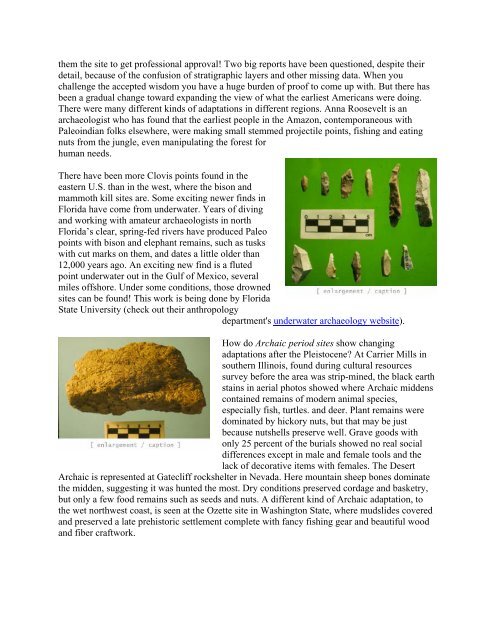INTRODUCTION TO ARCHAEOLOGY Nancy White - Touro Institute
INTRODUCTION TO ARCHAEOLOGY Nancy White - Touro Institute
INTRODUCTION TO ARCHAEOLOGY Nancy White - Touro Institute
Create successful ePaper yourself
Turn your PDF publications into a flip-book with our unique Google optimized e-Paper software.
them the site to get professional approval! Two big reports have been questioned, despite their<br />
detail, because of the confusion of stratigraphic layers and other missing data. When you<br />
challenge the accepted wisdom you have a huge burden of proof to come up with. But there has<br />
been a gradual change toward expanding the view of what the earliest Americans were doing.<br />
There were many different kinds of adaptations in different regions. Anna Roosevelt is an<br />
archaeologist who has found that the earliest people in the Amazon, contemporaneous with<br />
Paleoindian folks elsewhere, were making small stemmed projectile points, fishing and eating<br />
nuts from the jungle, even manipulating the forest for<br />
human needs.<br />
There have been more Clovis points found in the<br />
eastern U.S. than in the west, where the bison and<br />
mammoth kill sites are. Some exciting newer finds in<br />
Florida have come from underwater. Years of diving<br />
and working with amateur archaeologists in north<br />
Florida’s clear, spring-fed rivers have produced Paleo<br />
points with bison and elephant remains, such as tusks<br />
with cut marks on them, and dates a little older than<br />
12,000 years ago. An exciting new find is a fluted<br />
point underwater out in the Gulf of Mexico, several<br />
miles offshore. Under some conditions, those drowned<br />
sites can be found! This work is being done by Florida<br />
State University (check out their anthropology<br />
department's underwater archaeology website).<br />
How do Archaic period sites show changing<br />
adaptations after the Pleistocene? At Carrier Mills in<br />
southern Illinois, found during cultural resources<br />
survey before the area was strip-mined, the black earth<br />
stains in aerial photos showed where Archaic middens<br />
contained remains of modern animal species,<br />
especially fish, turtles. and deer. Plant remains were<br />
dominated by hickory nuts, but that may be just<br />
because nutshells preserve well. Grave goods with<br />
only 25 percent of the burials showed no real social<br />
differences except in male and female tools and the<br />
lack of decorative items with females. The Desert<br />
Archaic is represented at Gatecliff rockshelter in Nevada. Here mountain sheep bones dominate<br />
the midden, suggesting it was hunted the most. Dry conditions preserved cordage and basketry,<br />
but only a few food remains such as seeds and nuts. A different kind of Archaic adaptation, to<br />
the wet northwest coast, is seen at the Ozette site in Washington State, where mudslides covered<br />
and preserved a late prehistoric settlement complete with fancy fishing gear and beautiful wood<br />
and fiber craftwork.
















